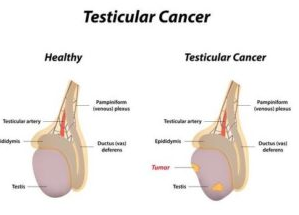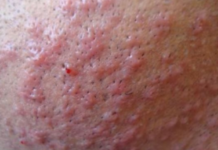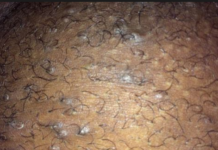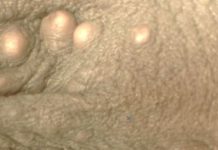What causes ingrown hair on scrotum? Ingrown hair by definition is a condition where hair curls back or grows sideways into the skin. It is common in people with coarse or curly hair. In most cases, it may or may not be accompanied by folliculitis or razor bumps. In this article we shall tell you about the causes of these bumps on testicle sack, the treatment of how to get rid of the bumps. We shall also provide you with images of how the bumps look like.

Ingrown hair on scrotum symptoms
Due to the varying causes of the ingrown, the symptoms will vary depending on the causes. Some people will experience severe symptoms whereas other will only have mild symptoms that clear on their own within a week or two. This is true for ingrown hair caused by poor shaving techniques.
Medical urgency will depend on how severe the symptoms are or the underlying cause of the bumps. Some common symptoms of an ingrown hair will include but not limited to the following:
- Severe or mild pain around hair follicles
- Itchy inflamed and swollen bumps on testicle sac and on thighs
- Most people will observe the scrotum turn dark also known as hyperpigmentation
- Small painful fluid-filled blisters
- Itching
- A burning sensation
- A continued urge to scratch
- Painful pus filled bumps
- The bumps may be hard and irritating
- Embedded hairs on scrotum and around the genital areas.
Most of the above-mentioned symptoms can be managed and controlled at home with natural home remedies. A remedy like aloe Vera gel contains anti-itching and anti-inflammatory properties which can really help in relieve symptoms such as itching, inflammation and the continued urge to scratch.
A cold compress can also offer relief for the inflammation and swelling accompanying the ingrown hair, the result is optimal for those bumps caused by poor shaving methods. Seek medical attention, however, when the symptoms last for more than a week or they are causing a lot of discomforts.
Ingrown hair on scrotum sack
The scrotum is the pouch of skin containing the testicles. It is an anatomical structure that consists of a suspended sack of skin and smooth muscle that is dual-chambered. The sac is common in most terrestrial male mammals and is located under the penis.
The scrotal skin is among the softest skin in the body. When one shaves the pubic hair, using a blunt of poor method of shaving, the hair may fail to protrude the skin when it grows. This way, it curls back into the skin, the hair follicles become blocked and start to accumulate sebum- an oily secretion of the sebaceous gland that keeps the skin moist. It may also attract bacteria and pus to form painful bumps.
Ingrown hair can also develop due to folliculitis, a skin condition where the hair follicles become infected and blocked making it hard for the hair to protrude the skin. As the hair grows, it curls back forming the ingrown hair.
Other causes will include over-production of sebum, apart from the formation of the ingrown hair bumps, it will also lead to inflammation of the skin. Dry skin can also cause difficulties for hair to protrude the skin thus forming the bumps. Contact dermatitis may also result in the irritation of the scrotal skin causing this kind of bumps.
Ingrown hair on scrotal sac is not life threating. The bumps may however contribute to transmission of infection especially when you scratch or pop them. Popped bumps will leave a wound which could lead to bacterial or viral infection. Scaring of the wound is also a risk factor of the ingrown hair.
No immediate medical attention is required, however, to relieve the symptoms such as itching, the burning sensation and inflammation, over the counter topical ointment maybe used. Natural remedy like aloe Vera as said can serve well in soothing the skin and speeding up the healing process. Seek medical attention if the ingrown hair fails to clear or the symptoms become unbearable.
Ingrown hair on scrotum pictures
Below and throughout this article we have provided images to help with visual guidance of how the bumps of ingrown hair appear. The appearance will vary from one person to the other depending on the underlying cause of the bumps.
When you are not aware of the underlying cause of the ingrown hair, we advise you have a dermatologist check to diagnose what the underlying condition could be. This is important to prevent the spread of infection and to facilitate early treatment and medication.




The images provided are to be used for illustration and not to substitute a professional physical health diagnosis. Be smart and seek medical assistance if you notice painful bumps that last for more than a week.
What causes ingrown hair on scrotum or testicle sac?
Ingrown hair can be painfully annoying. For most people, the common cause is improper shaving techniques. It is in most cases confused to be caused by sexually transmitted diseases and infections, this may or may not be true. When infected, an ingrown hair will become painful and filled with pus. This is a common symptom t those bumps caused by STD and appearing on the testicles sac.
Below we have provided a list of possible causes of ingrown hair on scrotum. For treatment and early medication, have a dermatologist look diagnose the condition, it is important to avoid over the counter treatment before you establish the underlying cause of the bumps on scrotum.
Curly hair on Scutum
Curly hair seems to be the main cause for the formation of ingrown hair. This is because after shaving the hair may curl back and grow inward the skin causing an ingrown hair.
Poor shaving
Poor shaving, especially for young adults and teenagers, is the other common cause for the formation of an ingrown hair. The sharp edges may curl back into the skin or fail to protrude the skin completely growing underneath the skin and forming an ingrown hair.
Dry skin
People with dry skin are those at the highest risk of developing ingrown hair on scrotum. To remedy or reduce your chances of developing the ingrown hair, make sure you apply shaving creams after and before shaving.
Accumulation of dead skin cells
Poor hygiene around the genital area and scrotum can also lead to the accumulation of dead skin cells, this will block the hair follicles. The blocked hair follicle will hinder the penetration of the hair strands, which will grow underneath the skin forming an ingrown hair.
Over secretion of sebum by the skin
The same effect of blocking the hair follicles can be caused by over-production of sebum- an oily secretion of the sebaceous gland that keeps the skin moist. The overproduction could be caused by hormonal fluctuation or by an underlying medical condition. Seek medical attention to confirm what the cause is.
Other causes of the ingrown hair will include the following
- Using a blunt razor
- Folliculitis
- Fordyce spots
- Sebaceous cysts
- Razor bumps
Ingrown hair bump under scrotum
It is not uncommon for middle-aged men or teenagers who are starting to shave their pubic hair to complain of painful bumps that develop few days after shaving. As said, these bumps are caused by improper shaving methods or using blunt shaving razor.
The complication is in two way, with poor shaving the hair strand can become sharp at the tip, it could curl back and start growing inwards into the skin. The other way of formation is, cutting the hair to close to the skin thus damaging the pores or hair follicles. What happens is, when the hair grows, t fails to protrude the skin thus grows underneath the scrotal skin forming painful bumps we are calling ingrown hair.
Though painful, this bumps are not life threatening and do not pose any health risk. They, however, embarrassing, annoying and could cause a lot of discomforts especially when one tries walking in tight pants.
A bump under scrotum can also be said to be a blind pimple. Also referred to as a closed come-done, or an under the skin pimple, a blind pimple is a deep bump with no head. A painful bump under the scrotal skin can thus be this kind of pimple. The best way to handle this kind of pimple is to avoid popping them. Restrain from squeezing or digging it with needles. This will help prevent the chances of an infection or scarring.
Ingrown hair scrotum cyst
A cyst on scrotum occurs when an ingrown hair becomes infected. This could be either by bacterial or viral attack. This is when the bumps will accumulate pus and become very painful. An ingrown hair cyst can thus be said to be a pilonidal cyst.
A pilonidal cyst in an abnormal pocket in the skin that usually contains hair and skin debris. It is almost always located near the tailbone at the top of the cleft of the buttocks. It is however not uncommon to have the cyst develop on the scrotal sack.
This kind of cyst occurs when hair punctures the skin and then becomes embedded. When infected, the resulting abscess or boil becomes extremely painful. To remove the bump, it can be drained by making a small incision or removing it surgically.
The cyst are common in young men. Those who sit for long hour are also at the highest risk of developing the cysts. A part from pain, the signs and symptoms of an infected ingrown hair cyst on scrotum will include the following:
- Redness of the scrotal skin
- Blood or pus may be discharged from the skin.
- Foul smell from the bumps discharge
Seek immediate medical attention by the sight of the above mentioned symptoms.
Ingrown hair on scrotum treatment, removal
Removing an ingrown hair from the scrotum is not a job for the weak or faint hearted. Apart from removing the ingrown hair, treatment will also involve managing the symptoms by making them bearable. No treatment is need for majority of ingrown hair cases, this is because the bump and pain will clear on their own with time.
Different ways are available to help you do that, they will include, but no limited to the following:
Exfoliation
This is done to try and get rid of dead skin from the scrotal sac. Exfoliation can be achieved through both mechanical and chemical means. When done correctly, it will help expose the new and radiant skin underneath the surface
Antibacterial topical ointments
At times, the bumps could be infected causing them to become painful and itchy. When this is the case, you doctor may prescribe topical antibiotics depending on the extent of the infection. You need to avoid over the counter medication to prevent complication such as drug allergies or not treating the actual underlying cause.
Use of steroid creams
Some health care provider may prescribe steroid creams depending on the extent of infection or other symptoms such as pain itching, inflammation and burning sensation.
Draining the bumps
For large painful fluid filled lumps on scrotum, draining them fluid out may be the best way to offer relief from the ingrown hair. To avoid scaring or popping the bump wrongly, have a professional health care provider drain the bump for you.
To perform the procedure, a small incursion can be made on the sides of the bump, a sterilized syringe can then be used to draw the contents of the bump out. After doing so, make sure to wash the resulting wound with a clean antiseptic solution and cover it to prevent infections.
Stop shaving or waxing
Reduce shaving or waxing until the ingrown hair is healed. This will prevent father irritation and offer time for the resulting wounds to heal.
Oral or ointment antibiotics
In cases of bacterial infection resulting from the ingrown hair bumps on scrotum, your doctor may prescribe a topical or oral antibiotics.
If the symptoms persist even after using the above mentioned treatment options, seek immediate medical attention. This will call for a further detailed medical diagnosis.
How to get rid of ingrown hair on scrotum – Home remedies
As said, most cases of ingrown hair do not call for immediate medical attention. The symptoms can thus be relieved and managed at home with simple natural remedies. The following are some of the available remedies to offer relief for the symptoms.
Be warned, the remedies discussed below will only help with the symptoms and not to treat the underlying cause. The results will also vary from person to person depending on how strong your immune system is or what the underlying cause of the ingrown hair is.
Try the following home remedies to get rid of ingrown hair on your scrotum:
Warm or cold compress
A warm compress softens the scrotal skin offering relief for the pain and irritation. Wet a face towel and hold it against the ingrown hair. Repeat the process gently until the embedded hair is brought to the surface of the skin.
Scrubbing with a mild soap
Scrubbing with a mild soap can help in coaxing the hair follicles making the ingrown hair more visible and very easy to get rid of.
Tea tree oil
Tea tree oil is another natural antibacterial, antiseptic and anti-inflammatory properties that will help heal the skin and prevent infection. Make sure you dilute the solution of tea tree oil.
Tweezing
A sterile needle, a pair or tweezers or a rotable medical device for ingrown hair to gently tweeze the hair out of the skin.
Sugar scrub
To get rid of the ingrown hair, you could consider using a sugar scrub. When properly used, it gently exfoliates the skin removing dead cells and help pull out the hair out of the skin. It will also make the scrotal skin appear silky smooth.
Baking soda paste
Baking soda past has a soothing effect on skin due to its strong anti-inflammatory properties. When applied on an ingrown hair, it will help reduce itching by exfoliating the skin and also reducing redness caused by the ingrown hair.
To prepare the remedy, simply mix a tablespoon of baking powder in a cup of water. Gently stir to achieve smooth paste, dab it on the affected part of the skin and leave it on for 20 minutes before rinsing it off.
Exfoliating with salt
A solution of chicken salt can also be used as an exfoliating agent. When used, it will help increase circulation, promote healing of ruptured bumps and reduce swelling.
Black tea bags
Black tea bags is the other simple home remedy that you can use to get rid of redness and inflammation caused by the ingrown hair. To use it as a remedy, moisten a black tea bag in warm water, rub it over eh affected are for two to three minutes. Repeat this twice in a day for optimal results.
Cucumbers
The irritating symptoms associated with an ingrown hair can be easily dealt with by a fresh piece of cucumber. The fruit is rich in hydrating and anti-inflammatory properties that effectively deals with the said symptoms.
Applying aloe Vera gel
Aloe Vera is the other very effective home remedy for ingrown hair or razor bumps. The soothing will provide an instant relief for itching and inflammation, the gel will also keep the skin moisturizing and speed up the healing process.
Raw organic honey
Honey has antibacterial properties that will prevent infection of the ingrown hair. It will also keep the skin moisturized and reduce swelling and inflammation.
Apple cider vinegar
Of all the mentioned home remedies, apple cider vinegar is the most common of them oil. To apply it as a remedy, dip a cotton ball in apple cider vinegar, apply it on the affected area and secure it with a bandage overnight. Repeat the process daily for a week for optimal results.
Ingrown Hair Removal Video
Sources and references.
- Ingrown hair on scrotal sac: http://www.healthedition.org/hair/ingrown-hair/ingrown-hair-on-testicle-sac-causes-symptoms-pictures-how-to-get-rid/
- How to get rid of ingrown hair: http://www.livestrong.com/article/175654-how-to-get-rid-of-ingrown-hair-on-the-bottom-of-a-scrotum/
- Scrotal bumps and lumps: http://buddymd.com/small-painless-lump-on-the-scrotum-sebaceous-cyst-vs-other-causes-and-management
- Scrotal pimple: http://www.treatcurefast.com/pimples/scrotum-pimple/pimple-on-scrotum-white-red-get-rid-painful-scrotum-pimple-bump-wont-pop/





